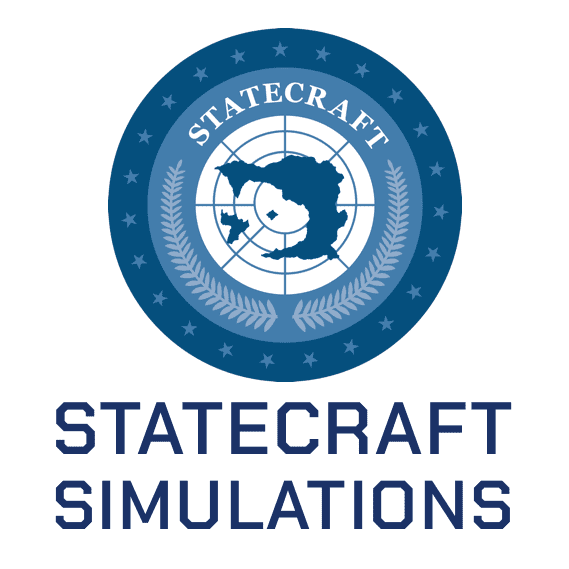U.S. FOREIGN POLICY SIM
Students take on key government roles and must apply foreign policy course concepts to navigate complex political dilemas and achieve sim goals.
- Automated: Instructors report an average 13% time savings
- Asynchronous & Online: Runs itself 24/7 for 3 to 5 weeks
- Super Support: Statecraft Help was rated 4.56 of 5 stars in 2019
- Customizable: Works great in classes with 5 to 1,000+ students
Launch the Interactive Tour to
see the sim interface in action
and learn how gameplay works.
Launch the Interactive Tour
to see the sim in action and
learn how gameplay works.
DIGITALLY TRANSPORT YOUR CLASS TO THE HALLS OF POWER
When students launch the U.S. Foreign Policy Simulation for the first time they’ll take an aptitude test that evaluates defining personality characteristics, such as extroversion and conscientiousness. Then they’ll receive position options that match their core strengths and contribution potential. Your class will represent the whole U.S. political system embodying key influencer roles such as:
Executive and Legislative:
President, Speaker of the House, Senate Majority Leader, Chair of the House Foreign Affairs Committee, Chair of the Senate Foreign Relations Committee Chair, House Majority and Minority Whips
Media Members:
Journalist, Reporter or Editor for the New York Times, Fox News, and CNN
Defense & Security Positions:
CIA Director, Director of National Intelligence, Secretary of Defense, Army Chief of Staff, Chief of Naval Operations, Air Force Chief of Staff
Interest Groups:
ACLU President, Executive Director and PR Director
Students have goals that correspond to their position and they accumulate points through accomplishing these goals every week. Some goals are competitive and others are collaborative. This dynamic requires students to work strategically with their classmates while pursuing their personal agenda; because that’s how real life works! Regardless of their role or title every student has the potential to dramatically affect the outcome of the game through their strategic moves.
effective, fun & helpful

Demonstrate Course Concepts
Students become part of the U.S. Political System so they experience first-hand how U.S. Government works. In order to succeed in the simulation, they’ll have to apply course-related knowledge.

Engage Students
Game-like play sucks students into the simulations where they must take ownership of their learning experience. They’re empowered to excel to their own personal limits and shine. Engagement enhances the knowledge acquisition process and makes it fun!
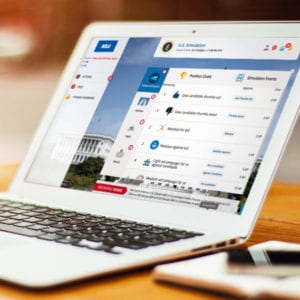
Save Time
The simulation is easy to set up and runs itself. You have a new tool to draw connections to course concepts and spark dynamic conversations. All-unique simulation scenarios every semester promote academic honesty. Instructor tools do tasks like grading for you.
use statecraft 100% ONLINE OR IN-PERSON

Easily create an unforgettable, dynamic online class
- Fully-automated: Once launched, the system prompts students and moves them through the simulation without any instructor action required
- Online chat & online messaging systems: to allow full class communication, student-to-student messaging and team collaboration all within the product interface
- 24/7 live asynchronous design: students can play whenever they want on their schedule without needing to coordinate class time
- Customer Support: available 7 days a week and ready to answer any and all online class questions!
This is a great choice for you if you’ve recently moved a class online and need an easy, effective way to spark student interest, create engagement and foster participation. It’s also a great choice if you’re unsure of what your class format will be next semester: these simulations will easily transition with you whether your class is 100% online, in-person or a blend.
"STUDENTS EXPERIENCE DECISION-MAKING HANDS-ON"

see the student interface
This is the exact screen the student in the role of Chair of Senate Foreign Relations Committee will see. Every student has the “Position Goals” and “Simulation Events” controls at the top of their screen, but depending on the position the other actions they can take – the icons running down the left side of the screen – will vary.
When you are the Chair of Senate Foreign Relations Committee one of your biggest goals is to keep your constituents happy so that they’ll reelect you at the end of the simulation! You can see on the screen below that you’re being asked to make a big decision whether or not to support a controversial war effort in Syria. If you choose correctly and your vote aligns with the citizen’s vote you’ll get points, but if you vote against your constituent’s desires you’ll lose points and your job could be in jeopardy. How do you make the right decision!? Start by gathering more info!
Role Spotlight: Chair of Senate Foreign Relations Committee
Position Goals
- This is where I view my position goals and learn how to gain simulation points.
- My biggest goal is reelection at the end of the sim, so I must be careful to make choices that my constituents like.
- This turn I'm confronted with a big decision regarding the war effort in Syria.
Simulation Events
- I can see all of the Senate events plus events caused by other students' actions.
- The Simulation Events are curated for my position.
Gather Info
- I can gain polling data on public opinion on certain topics, projected vote counts in the House and Senate and even candidate approval ratings in their district, state, or the country.
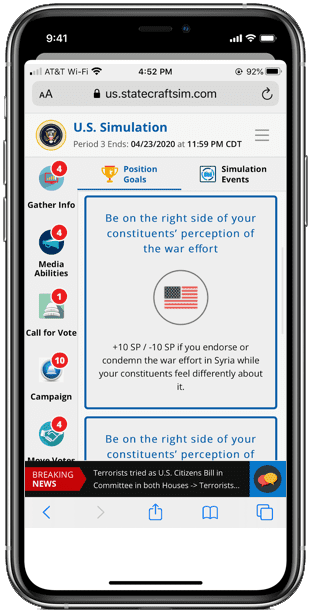
Chair of Senate Foreign Relations Committee Student view; depending on the student’s role the action options vary.
Media Abilities
- Here I interact with the media, which is an opportunity for me to sway public opinion.
- Example: I can make strategic alliances with the media members and give them stories that present a preferred viewpoint.
Call for Vote
- As Chair of the Senate Foreign Relations Committee I’ll need to call for votes on certain bills in my committee before they can go to the full Senate.
- Bills that pass in the Senate that are unpopular may impact my chances of reelection.
Campaign
- I can improve my approval rating through campaigning and working with the media to gain favorable coverage of my candidacy.
Time-Saving Instructor Tools
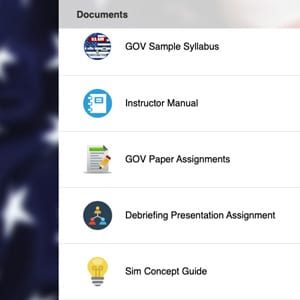
Student Assignments
Statecraft automatically assigns students to roles based on a brief assessment test designed for optimum role fit and student collaboration during the initial signup process.

Automated Student Prompting, Feedback & Calculations
Professors report an average of 13% time savings by using simulation tools that automatically prompt students, issue feedback, and guide outcomes.
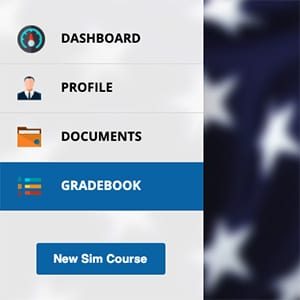
Automated Grading
The Statecraft system tracks all choices and outcomes and automatically reports final grades to the instructor in an excel exportable format for your convenience.
how it works
Easy Set-up & Launch
- Launch the simulation the second half of your semester
- Run through an easy 3-minute configuration to set the number of students and get the code for students to use to activate their simulation
- When students sign up with the code they’ll pay for the simulation
- You can have a minimum of 5 students per simulation with a maximum of 40; for larger classes you can run multiple simulations simultaneously to accommodate classes 1000+ students
- Students take a brief assessment and the system assigns them a role that aligns with their personality and interests
- Each role has personal goals to advance one's virtual "career" as well as organizational and/or national objectives
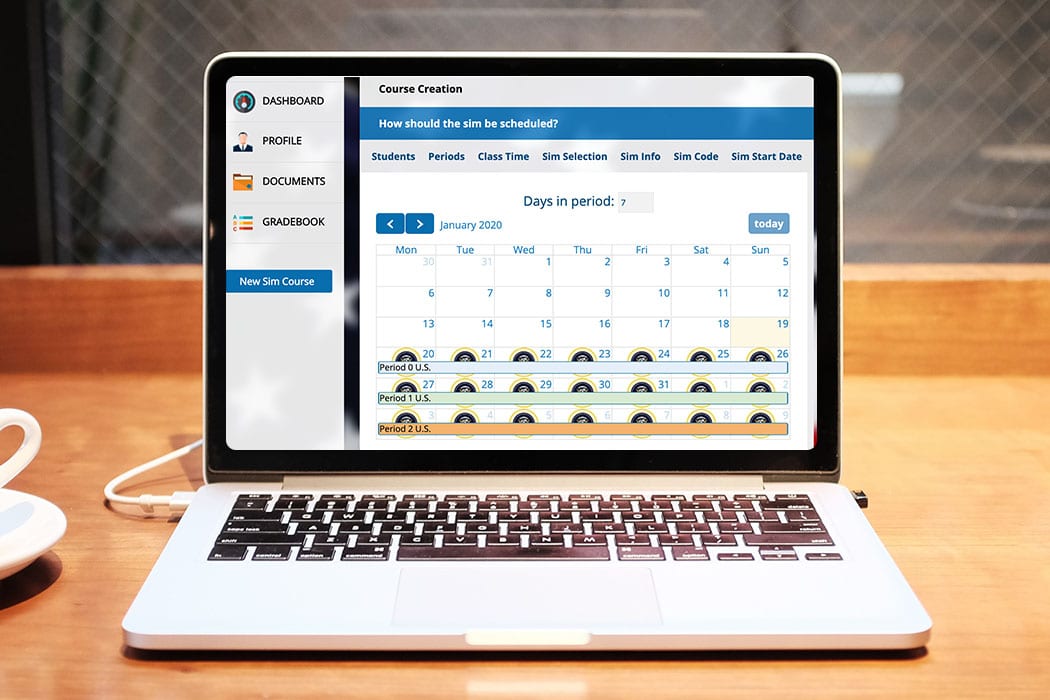

Playing the Simulation
- Everything is prompted by the system; it tallies points for moves and participation and calculate grades for you at the end of the simulation
- The simulation runs live 24-7 so students can play anytime without you needing to schedule class time or a computer lab.
- You’ll play for five weeks with turns or “periods” every week
- Period 0: students learn about their position abilities, current simulation events and how they gain simulation point
- Period 1 and 2: they gain new abilities and goals as they see the impact of their Period 1 choices and must make major decisions with important consequences
- Periods 3 and 4: students deal with the repercussions of their decisions and continue working towards their secret goals
- The goal is to maximize points and complete their goals before the end of the 4th period when the simulation concludes
The Instructor's Role
- Watch as the students collaborate and compete with one another to be successful and gain the most points
- Act as an executive consultant to help guide students and answer factual and strategic questions
- Statecraft help desk will assist students with any technical questions or troubleshooting
- Use the simulation events as learning opportunities to draw connections to course concepts
- If needed you can use your master account to make executive decisions, such as vetoing a bill


Ending the Simulation & Grading
- The simulation culminates in a final election where all the student's choices, strategy and alliances play out with ultimate results
- There are currently over 100 outcomes possible for the simulation! Every class experience is completely unique
- The system will offer instructors student’s final points to be considered in their course grade
- Students can still receive a good grade for participating fully in the simulation even if they technically “fail” at their role’s goals
- Instructor tools include paper assignments and class debriefing questions that are recommended after the conclusion of the simulation
- In the debriefing students are grouped and present their version of “what happened” so the class and the instructor gain insight into all perspectives
- Instructors often count the debrief exercise towards the final grade and report it to be a valuable and revealing class activity
If you’re looking for even more detailed information, see the Resources page for the instructor manual, sample syllabus and other helpful documentation.
Let's do this! Experience Statecraft for Yourself
Book your personal demo today! We’ll answer your questions, show you how these cool features work and help you set up your first U.S. Foreign Policy Simulation.
Course concepts covered
The multidimensional U.S. Foreign Policy Simulation covers the entire U.S. Foreign Policy curriculum. Using the simulation creates new opportunities to demonstrate how course concepts come to life. The events presented in the simulation are 100% inspired by events that have actually happened at some point in U.S. history. Your students will get a taste of how dramatic and exciting politics can actually be! This is not dry, boring material; students will be shocked and challenged working through the complicated dilemmas that U.S. leaders have to navigate every day.
Experiencing lessons first-hand means students are more engaged and they develop personal opinions about what they’re learning. Instructors report being able to have more productive lessons and more interesting conversations with students. This teaching tool empowers you to transform your class into an immersive, unforgettable learning experience you’ll enjoy just as much as your students
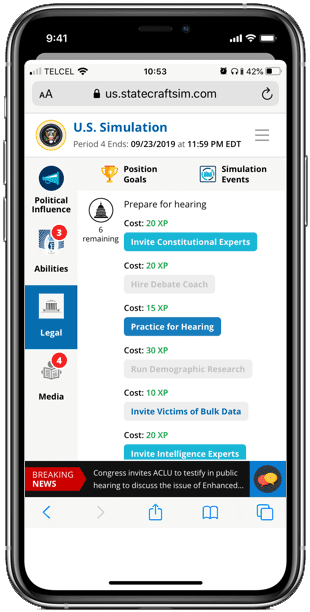
Constitutional Powers of the President vs. Congress in Foreign Policy
Role of Interest Groups
The War Powers Resolution
Relationship between Media and Government
Civil-Military Relations
Role of Political Parties and Ideology
Challenges and Politics of Intelligence Analysis
Institutional Checks and Balances & Judicial Review Concepts
Bureaucratic Politics & Organizational Routines
Reasons the U.S. Foreign Policy Simulation is so effective:
- An innovative way to teach concepts beyond traditional lectures
- Concepts become personal and experienced by students
- Students are engaged and participating both inside and outside of class
- Engagement enhances the knowledge acquisition process
- Students take ownership of their experience and are empowered to shine
- Teaches career skills like leadership, teamwork, negotiation and strategic thinking that help them be more employable
- Students must apply course knowledge and do context-based problem solving to succeed
- Working in teams on common goals fosters student collaboration and relationship building even in large lecture classes
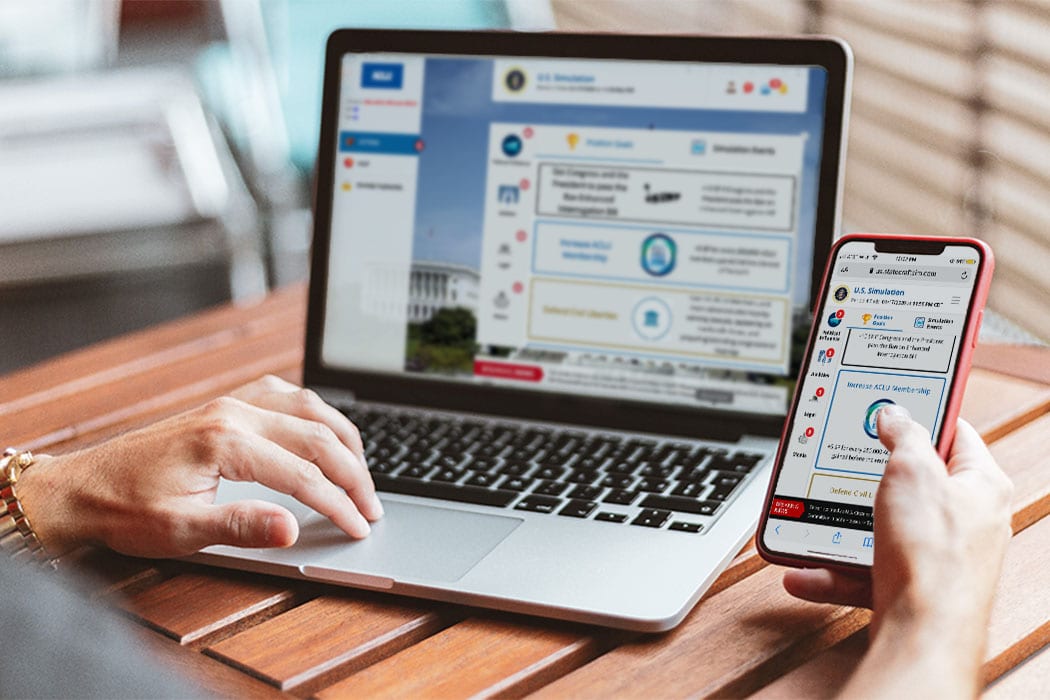

Results you’ll experience:
- Heightened student engagement & greater attendance
- Quality student questions and requests for strategy consultation
- Students are able to discuss course concepts intelligently and develop strong opinions that spark interesting class conversations
- More camaraderie among the students, social connections, sense of community
- Students will form study groups and you’ll hear students speaking about topics such as the checks and balances of the bill of rights outside the classroom
- Your class popularity will increase due to previous student recommendations
Costs much less than a textbook
Students pay
$24.75
- One-time payment per student per semester
- You assign the simulation to students, give them the activation code and they purchase it just like they would purchase a textbook
- Statecraft cares deeply about facilitating student learning so we keep pricing as accessible as possible
4.72
out of 5 stars
Instructors rated Statecraft Customer Service 4.72 of 5 stars User Satisfaction Surveys
Excellent Customer Support
- You have help at every step of the process: from set-up to implementation with quick assistance for any questions you have along the way
- Both you and students can reach out to us directly at any time
- Our customer support is available 7-days a week from 7am to 11pm; we try to answer fast and always get back to you within 24 hours
- We’ll take care of students' technical questions so that you just handle the political questions
- Teachers who reach out and ask questions report some of the best overall simulation class experiences, so we highly encourage you to contact us!
"a powerful active learning tool"

Get started today to experience how Statecraft brings U.S. Foreign Policy to life in your course!
You can sign up online now to get started immediately or book your personal demo! We’ll give you a complete product tour, answer all of your questions and help you configure your first U.S. Foreign Policy Simulation.
Statecraft Project LeaderMaker
As a company, we are passionate about student success! Our mission is to engage students in social science topics in a way that ignites their curiosity, excitement for learning, and social skills regardless of their learning styles or socio-economic disadvantages. In the spirit of this mission, we founded the Statecraft Project LeaderMaker, which donates simulation accounts to low-income high schools.
How it works:
- Colleges use Statecraft Simulations in social science classes
- Statecraft donates simulation accounts to low income high schools
- At-risk students are reengaged in school and gain employability skills
- More students graduate high school with leadership and employment skills
The number of accounts donated is determined by evaluating school’s free lunch percentage and unique budget constraints. Contact Joe at [email protected] to learn more about the program.

Let's Keep In Touch
Sign up for the Statecraft Newsletter and we’ll send you product updates, simulation tips and exclusive offers straight to your inbox!
